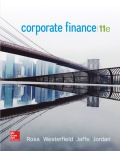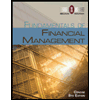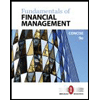
EBK CORPORATE FINANCE
11th Edition
ISBN: 8220102798878
Author: Ross
Publisher: YUZU
expand_more
expand_more
format_list_bulleted
Question
Chapter 19, Problem 12QP
Summary Introduction
To determine: The Homemade Dividends in 2 years.
Introduction: The term dividends allude to that portion of proceeds of an organization which is circulated by the organization among its investors. It is the remuneration of the investors for investments made by them in the shares of the organization.
Expert Solution & Answer
Want to see the full answer?
Check out a sample textbook solution
Students have asked these similar questions
Please help with these questions.
Please help with 5-6.
Please help with questions 5-50.
Chapter 19 Solutions
EBK CORPORATE FINANCE
Ch. 19 - Dividend Policy Irrelevance How is it possible...Ch. 19 - Stock Repurchases What is the impact of a stock...Ch. 19 - Dividend Policy It is sometimes suggested that...Ch. 19 - Dividend Chronology On Tuesday, December 8,...Ch. 19 - Prob. 5CQCh. 19 - Prob. 6CQCh. 19 - Dividends and Stock Price Last month, Central...Ch. 19 - Prob. 8CQCh. 19 - Dividend Policy For initial public offerings of...Ch. 19 - Investment and Dividends The Phew Charitable Trust...
Ch. 19 - Use the following information to answer the next...Ch. 19 - Stock Repurchases How do you think this tax law...Ch. 19 - Dividends and Stock Value The growing perpetuity...Ch. 19 - Bird-in-the-Hand Argument The bird-in-the-hand...Ch. 19 - Dividends and Income Preference The desire for...Ch. 19 - Dividends and Clientele Cap Henderson owns Neotech...Ch. 19 - Prob. 17CQCh. 19 - Prob. 18CQCh. 19 - Prob. 19CQCh. 19 - Prob. 20CQCh. 19 - Prob. 1QPCh. 19 - Stock Dividends The owners equity accounts for...Ch. 19 - Prob. 3QPCh. 19 - Stock Splits and Stock Dividends Roll Corporation...Ch. 19 - Prob. 5QPCh. 19 - Share Repurchase In the previous problem, suppose...Ch. 19 - Prob. 7QPCh. 19 - Prob. 8QPCh. 19 - Prob. 9QPCh. 19 - Prob. 10QPCh. 19 - Prob. 11QPCh. 19 - Prob. 12QPCh. 19 - Stock Repurchase Flychucker Corporation is...Ch. 19 - Prob. 14QPCh. 19 - Prob. 15QPCh. 19 - Prob. 16QPCh. 19 - Prob. 17QPCh. 19 - Prob. 18QPCh. 19 - Prob. 19QPCh. 19 - Prob. 20QPCh. 19 - Prob. 1MCCh. 19 - Jessica believes that the company should use the...Ch. 19 - Prob. 3MCCh. 19 - Another option discussed by Tom, Jessica, and...Ch. 19 - Prob. 5MCCh. 19 - Does the question of whether the company should...
Knowledge Booster
Similar questions
- Please help with the problem 5-49.arrow_forwardPlease help with these questionsarrow_forwardIn 1895, the first U.S. Putting Green Championship was held. The winner's prize money was $170. In 2022, the winner's check was $3,950,000. a. What was the percentage increase per year in the winner's check over this period? Note: Do not round intermediate calculations and enter your answer as a percent rounded to 2 decimal places, e.g., 32.16. b. If the winner's prize increases at the same rate, what will it be in 2053? Note: Do not round intermediate calculations and enter your answer as a percent rounded to 2 decimal places, e.g., 32.16. a. Increase per year b. Winners prize in 2053 %arrow_forward
- Derek plans to retire on his 65th birthday. However, he plans to work part-time until he turns 73.00. During these years of part-time work, he will neither make deposits to nor take withdrawals from his retirement account. Exactly one year after the day he turns 73.0 when he fully retires, he will begin to make annual withdrawals of $183,008.00 from his retirement account until he turns 94.00. After this final withdrawal, he wants $1.52 million remaining in his account. He he will make contributions to his retirement account from his 26th birthday to his 65th birthday. To reach his goal, what must the contributions be? Assume a 6.00% interest rate. Round to 2 decimal places.arrow_forwardDerek plans to retire on his 65th birthday. However, he plans to work part-time until he turns 71.00. During these years of part-time work, he will neither make deposits to nor take withdrawals from his retirement account. Exactly one year after the day he turns 71.0 when he fully retires, he will begin to make annual withdrawals of $177,333.00 from his retirement account until he turns 94.00. He he will make contributions to his retirement account from his 26th birthday to his 65th birthday. To reach his goal, what must the contributions be? Assume a 9.00% interest rate. Submit Answer format: Currency: Round to: 2 decimal places.arrow_forwardDerek plans to retire on his 65th birthday. However, he plans to work part-time until he turns 72.00. During these years of part-time work, he will neither make deposits to nor take withdrawals from his retirement account. Exactly one year after the day he turns 72.0 when he fully retires, he will wants to have $3,104,476.00 in his retirement account. He he will make contributions to his retirement account from his 26th birthday to his 65th birthday. To reach his goal, what must the contributions be? Assume a 8.00% interest rate. Submit Answer format: Currency: Round to: 2 decimal places.arrow_forward
- Banking and finance sector ma job kaise payearrow_forward1. Bond X is worth $91 today. The bond will mature in one year and pay $100 or $84 with probabilities 0.75 and 0.25, respectively. Assuming the bond pays no cash flows during the year, which of the following is closest to the expected return on the bond? 5% 0% 0% 5% 0% 2. At the beginning of the year, a mutual fund has a NAV of $20. At the end of the year, the NAV is $21 and the fund has received no dividends or other distributions throughout the year. The return on the fund’s benchmark over the same period of time was 10%. Suppose the fund incurred expenses of $2 per fund share during the year. What was the return on the fund’s underlying portfolio before any expenses that affected NAV? Did this before-expense return beat the fund’s benchmark? 15%; Yes, the fund’s underlying portfolio beat its benchmark 15%; No, the fund’s underlying portfolio beat its benchmark 0%; No, the fund’s underlying portfolio beat its benchmark 20%; Yes, the fund’s underlying portfolio beat its benchmark…arrow_forward1. Which of the following assets is most likely to trade over the counter but still have high liquidity? a. A short-term Treasury bond b. A long-term corporate bond c. A short-term corporate bond d. A large-cap stock e. A small-cap stock 2. Assume you purchased 600 shares of XYZ common stock on margin at $35 per share from your broker. If the initial margin is 60%, the amount you borrowed from the broker is closest to _________. a. $8,500 b. $21,000 c. $29,500 d. $12,500 e. $16,000 3. You invest $1,550 in security A with a beta of 1.4 and $1,350 in security B with a beta of 0.4. The beta of this portfolio is closest to _____________ . a. 0.95 b. 0.90 c. 1.35 d. 1.05 e. 1.15 4. Which of the following orders is most likely to increase the difference between the highest bid price and the lowest ask price? a. A large market order b. A large limit order c. A small limit order d. A small market order e. There will be no major difference between these 5. Bond X is worth $91 today.…arrow_forward
- 1. At the beginning of the year, a mutual fund has a NAV of $20. At the end of the year, the NAV is $21 and the fund has received no dividends or other distributions throughout the year. The return on the fund’s benchmark over the same period of time was 10%. What was the return to investors in the fund? Did the fund’s return to investors beat the benchmark return? a. 5%; No, the fund did not beat its benchmark b. 10%; No, the fund did not beat its benchmark c. 15%; No, the fund did not beat its benchmark d. 20%; Yes, the fund beat its benchmark e. None of the above 2. You are advising a pension fund that is required to have a portfolio risk of 5%. Which of the following would be the portfolio optimization problem for constructing their fund? a. Maximize return subject to a constraint that portfolio volatility is 5% b. Not enough information c. Maximize the Sharpe ratio with no additional constraints d. Minimize the risk needed to get their long-term return target e. None of the…arrow_forwardHow the Synthesizing Qualitative Research Methodology in Case Study Research can be used in case of the collapse of Circuit City? What cause the Circuit City Failed to Adapt to E-commerce? Why DMAIC, a data-driven problem-solving method, and Lean Six Sigma did not save Circuit City?arrow_forwardHow was the poor strategic decisions lead to economic downturns of Circuit City Company? What are the sequence of key events and problems that contribute to its collapse. Could you please explain each one them? How Lean Six Sigma businesses can reduce waste, improve efficiency, and enhance customer satisfaction?arrow_forward
arrow_back_ios
SEE MORE QUESTIONS
arrow_forward_ios
Recommended textbooks for you
 Fundamentals of Financial Management, Concise Edi...FinanceISBN:9781285065137Author:Eugene F. Brigham, Joel F. HoustonPublisher:Cengage Learning
Fundamentals of Financial Management, Concise Edi...FinanceISBN:9781285065137Author:Eugene F. Brigham, Joel F. HoustonPublisher:Cengage Learning Fundamentals of Financial Management, Concise Edi...FinanceISBN:9781305635937Author:Eugene F. Brigham, Joel F. HoustonPublisher:Cengage Learning
Fundamentals of Financial Management, Concise Edi...FinanceISBN:9781305635937Author:Eugene F. Brigham, Joel F. HoustonPublisher:Cengage Learning

Fundamentals of Financial Management, Concise Edi...
Finance
ISBN:9781285065137
Author:Eugene F. Brigham, Joel F. Houston
Publisher:Cengage Learning

Fundamentals of Financial Management, Concise Edi...
Finance
ISBN:9781305635937
Author:Eugene F. Brigham, Joel F. Houston
Publisher:Cengage Learning